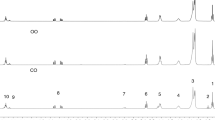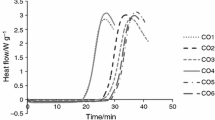Abstract
Oxidative stability of VOO is widely determined by Rancimat test, an accelerated method that shortens analysis time. The most usual temperature used for Rancimat analysis is 98 °C; however several authors have reported oxidative stability values at different temperatures higher than 98 °C (110 °C, 120 °C) in order to reduce the analysis time. In this study the effect of temperature on Rancimat method for VOO analysis, measuring the method reproducibility at each temperature, has been evaluated. Method precision expressed as the relative standard deviation (RSD) was ranged from 1.14 to 5.84%, indicating that analytical method was repeatable even at 140 °C. A mathematical model is presented to transform the induction period inter-temperatures (98–140 °C). The results suggested 110 °C as the more adequate temperature since the analysis time was shortened by 63% compared to induction period obtained at 98 °C; the inter-conversion 98–110 °C presented low differences between theoretical value obtained from mathematical model and experimental value obtained by Rancimat apparatus. To shorten analysis time, 84 and 92% respectively, 120 and 130 °C can be used too; although some samples can present higher differences between theoretical and experimental induction period values because of the different oxidation mechanism at each temperature.



Similar content being viewed by others

References
Williams KA (1966) Oils, fats and fatty foods. 4th edn. J&A Churchill, London, p 59
King AE, Roschen HL, Irwin WH (1933) Oil Soap 10:204–207
Hadorn H, Zurcher K (1974) Lebensm Rundsch 70:57
deMan JM, deMan L (1984) J Am Oil Chem Soc 61:534–536
Laubli M, Bruttel P (1986) J Am Oil Chem Soc 63:792–795
deMan JM, Tie F, deMan L (1987) J Am Oil Chem Soc 64:993–996
Gutierrez F (1989) Grasas Aceites 40:1–5
Tous J, Romero A, Diaz I (1999) Acta Hort 474:639–642
Servili M, Baldioli M, Miniati E, Montedoro GF (1996) Riv Ital Sostanze Grasse 73:55–60
Uceda M, Frias L (1975) Harvest dates. Evolution of the fruit oil content, oil composition and oil quality. In: Proceedings of the Segundo Seminario Oleicola Internacional, International Olive Oil Council, Cordoba, Spain, pp 125–130
Martinez JM, Muñoz E, Alba J, Lanzón A (1975) Grasas Aceites 26:379–385
European Commission Regulation EEC/2568/91 (1991) Off J Eur Commun L 248:1–82
Vazquez-Roncero A, Janer del Valle C, Janer del Valle ML (1973) Grasas Aceites 24:350–357
IUPAC (1973) In: Paquot C, Hautfenne A (ed) Determination of tocopherols and tocotrienols in vegetable oils and fats by HPLC. Standard methods for the analysis of oils, fats and derivatives, Method 2432, 7th edn. Blackwell, Oxford
Minguez-Mosquera MI, Gandul-Rojas B, Garrido-Fernandez J, Gallardo-Guerrero L (1990) J Am Oil Chem Soc 67:192–196
Jebe TA, Matlock MG, Sleeter RT (1993) J Am Oil Chem Soc 70:1055–1061
Frankel EN (1998) Lipid oxidation. Oily Press, Dundee, Scotland, pp 97–114
Laubli M, Bruttel P (1986) J Am Oil Chem Soc 63:792–795
Hasenhuettl GL, Wan PJ (1992) J Am Oil Chem Soc 69:525–527
Reynhout G (1991) J Am Oil Chem Soc 68:983–984
Gutierrez F, Jimenez B, Ruiz A, Albi MA (1999) J Agric Food Chem 47:121–127
Aparicio R, Roda L, Albi MA, Gutierrez F (1999) J Agric Food Chem 47:4150–4155
Beltran G (2000) Influence of ripening process in Olea europaea L. fruits on the physicochemical characteristics of the oils. Ph.D. Thesis, Universidad de Jaén, Spain
Acknowledgements
The authors are indebted to Maite Ruano for technical assistance with oil analyses. This work has been financed by Project CAO01-019 from Programa de Mejora de la Calidad del Aceite de Oliva y de Aceitunas de Mesa (FAGA-FEOGA Garantía)
Author information
Authors and Affiliations
Corresponding author
Rights and permissions
About this article
Cite this article
Mateos, R., Uceda, M., Aguilera, M.P. et al. Relationship of Rancimat method values at varying temperatures for virgin olive oils. Eur Food Res Technol 223, 246–252 (2006). https://doi.org/10.1007/s00217-005-0185-9
Received:
Revised:
Accepted:
Published:
Issue Date:
DOI: https://doi.org/10.1007/s00217-005-0185-9



